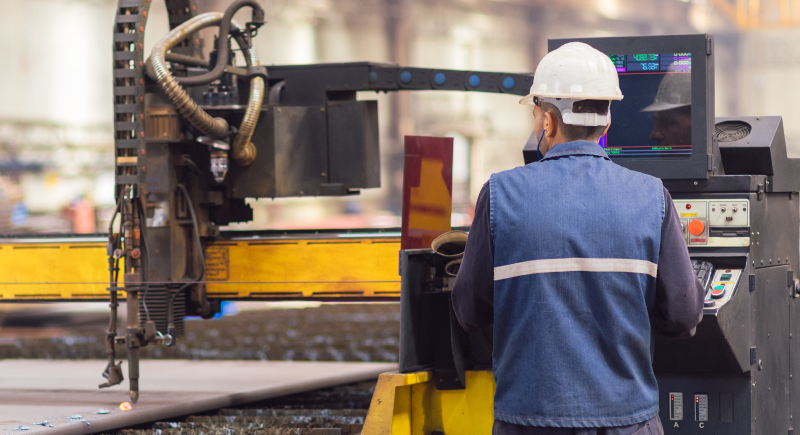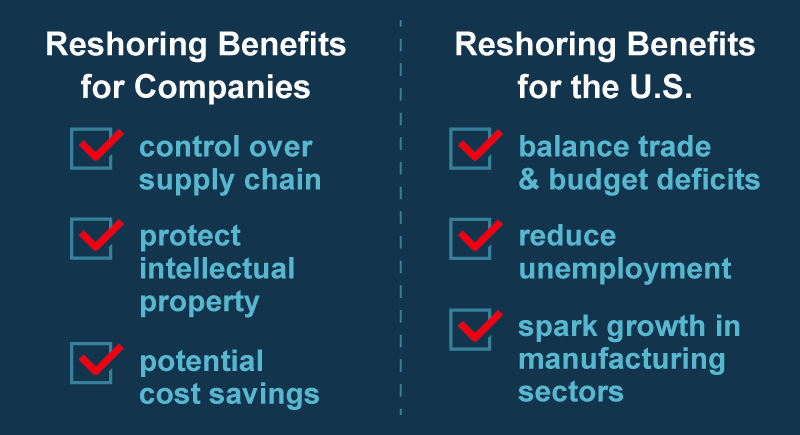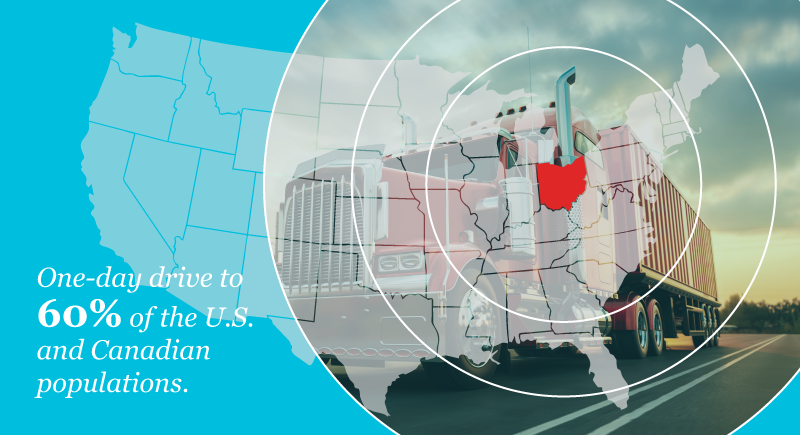Why do companies reshore?
Reshoring is becoming an increasingly persistent topic in executive boardrooms, government offices, and more. But what does it mean? And why now?
In a recent report from the nonprofit institute Heartland Forward entitled Reshoring America: Can the Heartland Lead the Way? ‘reshoring’ is defined as “the return of manufacturing, outsourced personnel, and services from overseas back to the United States where the products and services are sold.”
Although reshoring efforts were gaining momentum in recent years, reshoring is becoming more important than ever. The coronavirus pandemic exposed an overreliance on foreign nations for critical goods and highlighted the gaps in American manufacturing. When the U.S. began seeing infection rates surge, there were widespread shortages of personal protective equipment (PPE) and medical supplies, because of producing countries blocking their export. Delays, shortages, and other supply chain disruptions have been all too common and returning to U.S. manufacturing may be the best way to reduce these challenges in the future.
Offshoring was the trend for decades due to cheaper labor costs and looser regulations. For trends to remain successful they must consider long term benefits, not just short-term gains. Now, many companies are confronting the limitations of offshoring, as well as the hidden costs. Heartland Forward’s recent report explains that firms may fail to accurately determine the costs of production overseas by as much as 20%. They estimate that around 10-30% of projects considering relocation to countries outside the U.S. would find it more affordable to expand here at home instead.
What is the Reshoring Initiative?

The Reshoring Initiative®, a coalition of major manufacturing trade associations and technology suppliers, is recognized as a leading voice for bringing back and keeping manufacturing jobs here in the U.S. According to this industry-led organization, “the Reshoring Initiative is focused on helping companies shift collective thinking from ‘offshoring is cheaper’ to ‘local reduces the total cost of ownership’.” They argue that there are many factors to consider when determining the affordability of offshoring vs. reshoring – including lead times, product quality, consistency, skilled workforce, tax incentives, and other key reasons.
With the momentum of the reshoring initiative gaining in popularity, legislation may help encourage even more companies to return their manufacturing supply chain to the United States. The President has issued an executive order implementing a “Buy American” program. This executive order further establishes a federal procurement policy featuring a waiver system. To be granted a waiver allowing the use of non-U.S. goods, products, or materials, federal agencies will have to state their case to the Director of the Made in America Office, with sufficient proof that their project can’t be completed with U.S. items alone. Parameters including cost have been increased to further complicate the use of non-American-made products and non-American-sourced materials.
Encouraging companies with tax incentives to retain the capacity to manufacture critical supplies during a national emergency is another cornerstone of the federal government’s plan to not only reshore manufacturing facilities but also to better prepare for future crises.
What is an advantage of reshoring?
The benefits of reshoring can be described from various perspectives including those of companies and the United States.

For companies, reshoring means control over the supply chain, protection for intellectual property, gaining efficiencies, and potential cost savings — not to mention a boost to public relations efforts.
The United States benefits as well by balancing trade and budget deficits, reducing unemployment, keeping the country competitive, and sparking growth in sectors supporting manufacturing.
Reshoring efforts are working. In fact, 20% of goods and products previously manufactured in Asia have recently returned to being sourced in the United States. Because of these efforts, jobs resulting from reshoring activity are estimated to have amounted to over 400,000 in 2019. This number is expected to grow as interest in reshoring continues to climb.
What companies are reshoring?
Companies are choosing reshoring in increasing numbers for several reasons. For instance, Heartland Forward shared the thoughts of Extreme Trucking president Daniel Burrows in their recent report including his reasons for focusing on local sourcing options in the U.S.
Burrows explains “the simplification of our supply chain and logistics cannot be overestimated, especially in our COVID-19 environment. The pandemic demands fast and strategic decisions in the face of uncertainty. We can still serve our customers if a plant in Mexico is shut down because we have a supplier in Ohio up and running.”
Several companies across the nation are working on reshoring efforts. For example, Softbank, General Motors, Spring, Infosys, Walmart, and Apple have all announced reshoring initiatives.
Where should companies reshore?
Companies interested in reshoring should seek out an open, secure, cost-effective home for their supply chain. Ohio meets these needs and more with resourcefulness and proven innovation. Furthermore, Ohio’s business environment attracts global investment with a simple tax structure, central location, and a legacy of manufacturing expertise.
Ohio is home to a large, diversified economy with a business-friendly environment. With a tax structure that is geared to the needs of business growth and development, companies’ reshoring in Ohio can expect no state corporate income or profits tax as well as no tax on products sold outside of the state. In addition, Ohio has no state tax on machinery and equipment investments and no state tax on research and development investments.

Proximity to suppliers as well as customers is just one of the benefits of reshoring and Ohio is ideal for reaching both. With a one-day drive, companies have access to 60% of the U.S. and Canadian populations. Ohio also offers road, rail, ports, and air infrastructure as well as foreign trade zones, all to make moving goods, products, and materials easier for companies.
Ohio is built on a legacy of manufacturing and has the labor pool and expertise to staff facilities in every part of the supply chain. Additionally, Ohio has the third largest manufacturing workforce in the United States. Ohio’s affordable cost of living is another advantage. Companies looking to reshore while still realizing cost savings on labor benefit from manufacturing wages roughly 9% lower than the U.S. average. And the state is productive, too. Ohio is ranked second in the nation in raw steel production every year of the last decade. Ohio is also #1 for people employed in the state’s plastic and rubber manufacturing industry, representing the largest plastic and rubber talent pool in the U.S.
As the world recovers from the effects of the pandemic, reshoring could be the best way to ensure shortages of critical supplies remains a thing of the past. The benefits of reshoring are not confined to worldwide crises, however. Businesses across the country are realizing the advantages of reshoring their manufacturing facilities, services, materials sourcing, and more. Locating manufacturing facilities in Ohio can reduce supply chain disruptions and support business growth. JobsOhio and its extensive network offer complementary support tailored to fast-track company success. Learn more about how JobsOhio can assist companies that locate or expand their operations in the state.